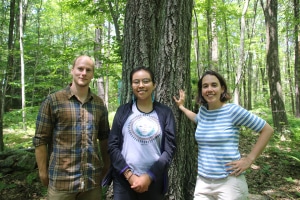Nov. 12, 2019

As oak leaves rattle and pool beneath trees in Arizona’s high country, one 100-year-old oak tree in Massachusetts is attracting a crowd of admirers online thanks to the work of NAU researchers and a Coconino Community College student. The tree is a scientific wonder—not because of its unique looks or a special way it grows, but because of its voice.
The idea for the Harvard Forest Witness Tree, a social media outreach project led by postdoctoral fellow Tim Rademacher of the Center for Ecosystem Science and Society (Ecoss) and Harvard University, began as a public outreach component of a study investigating the effect of environmental changes on wood growth, funded by the National Science Foundation.
“The tree is wired with sensors that measure its growth, sap flow, local climate and other factors in real-time,” Rademacher said. “Because we were measuring these things anyway, we thought, why not use the data to give the tree a voice?”
Since the tree’s Twitter account launched in July, it has gained more than 7,700 followers who regularly share the tree’s messages and ask it questions—which it answers. @AWitnessTree’s Twitter and Facebook presence is the first of its kind in North America.
Helping a tree to trend on social media was a process two years in the making. In summer 2018 and 2019, Rademacher worked at Harvard Forest with undergraduate interns Shawna Greyeyes of Coconino Community College and Kyle Wyche of University of Pittsburgh to deploy the sensors and write analytical code that would connect data streams from the tree to public messages on Twitter and Facebook.
Greyeyes, who is originally from Shonto, Arizona, worked on message coding and a website for the tree in summer 2019.
“I kept several things in mind while creating the messages,” she said. “We went with a first-person narrative, with context and visuals that are hopefully easy to understand and connect with.”
This year, Greyeyes is a SEEDS SPUR Fellow for the Ecological Society of America and will present her research on the Witness Tree at the society’s national conference in summer 2020.
Andrew Richardson, a Regent’s Professor in Ecoss and the School of Informatics, Computing, and Cyber Systems (SICCS) and principal investigator on the research, said he hopes the project helps those who may never visit Harvard Forest to connect with the Witness Tree and the long history written into its rings.
“Individual trees have held deep meaning for people across time, and it’s exciting that Tim and Shawna have imagined a new way, in our hyper-technological moment, for people to connect with trees, and nature,” he says.
Rademacher pointed out that many other social media accounts online represent non-humans: pets, landmarks or even other trees, but this project is unique because no humans are tweeting. It’s all the tree, with the help of the algorithm. Rademacher built the tree’s computer program to work automatically.
“We are not sitting there at the computer tweeting for the tree,” he said. “When it’s hot, the data tells us through the tree, not the other way around.”
Twenty-four hours a day, several times a minute, the program scans the data coming out of the tree’s sensors and cameras, watching for thresholds that signal something ecologically significant in the tree’s life: a surge in growth, a heat wave, heavy rainfall or seasonal changes in leaves. The tree often tweets in these unique moments, and it also posts photos of visits from wildlife and monthly summaries of its growth and local climate.
“How are you doing? @awitnesstree,” Greyeyes tweeted one recent afternoon. Within four minutes, the tree had replied: “It is 7.7 °C (45.9 °F) right now—warmer than average, which means I will respire more carbon back to the atmosphere.”
Rademacher said the next steps for the project will depend on new funding and include do-it-yourself tweeting tree kits for educators to deploy in their local communities. They also hope to translate the tree’s messages into French and Spanish to expand its audience around the world.

Kate Petersen | Center for Ecosystem Science and Society


